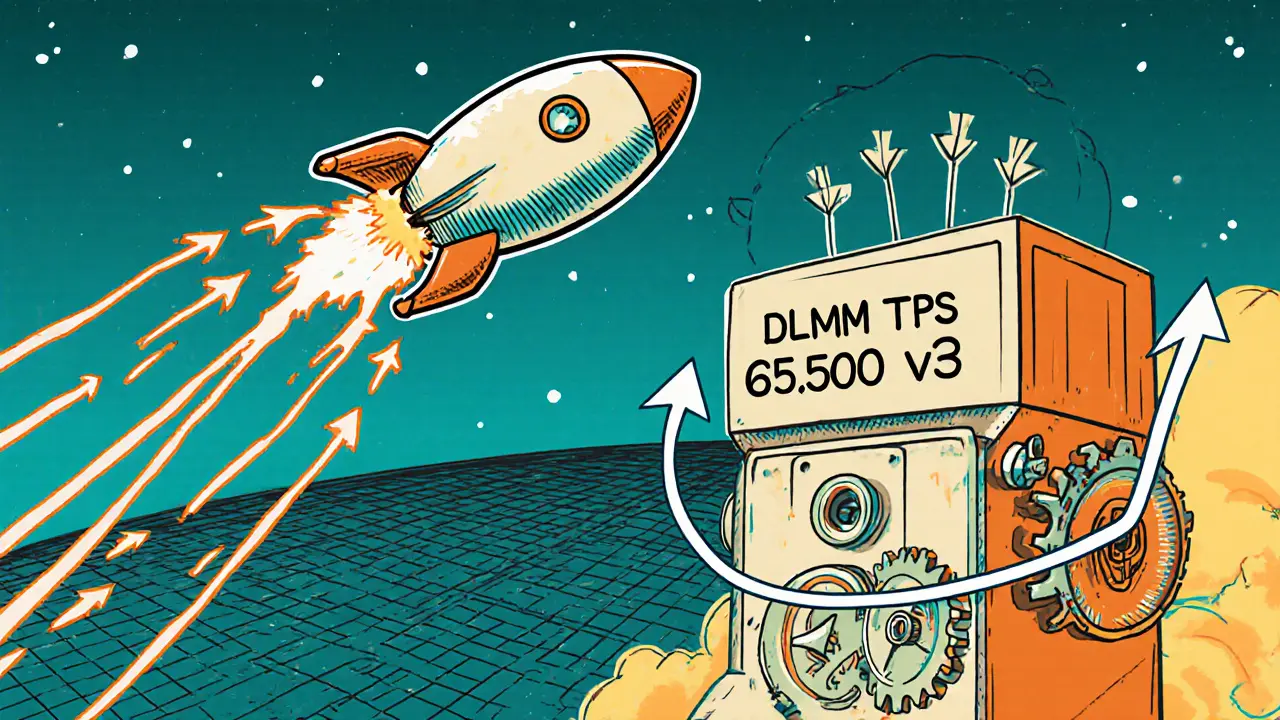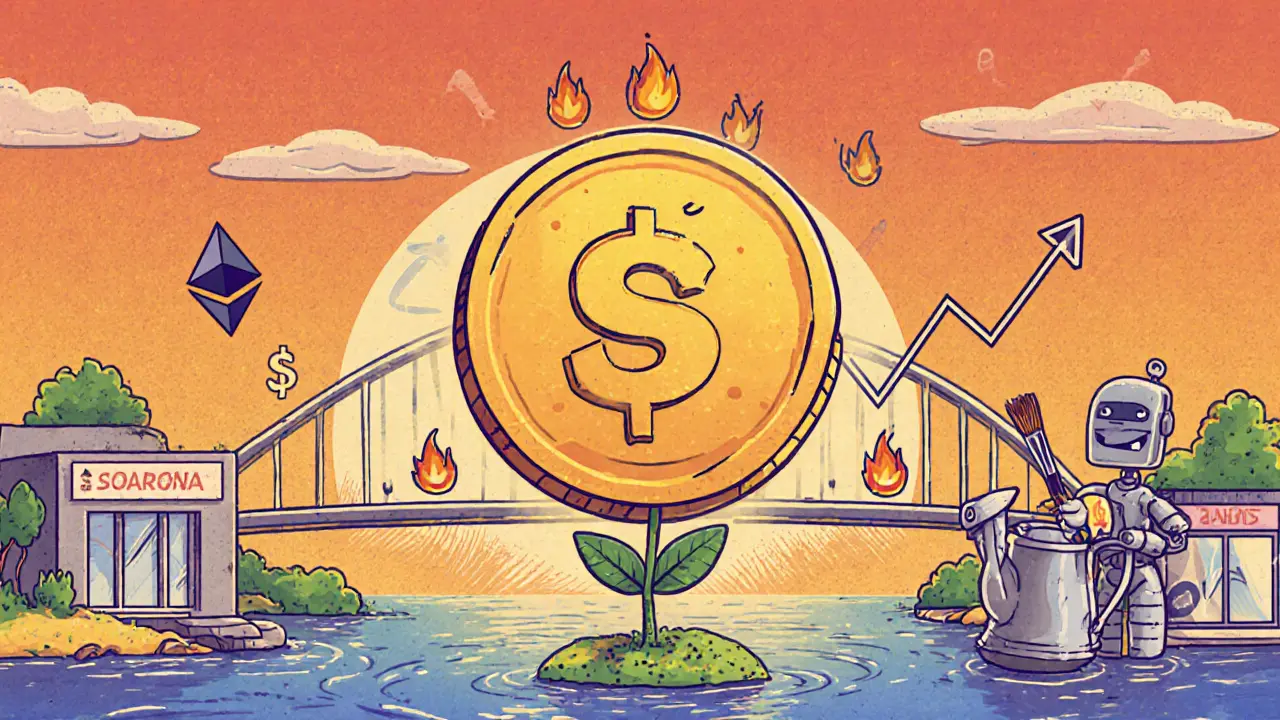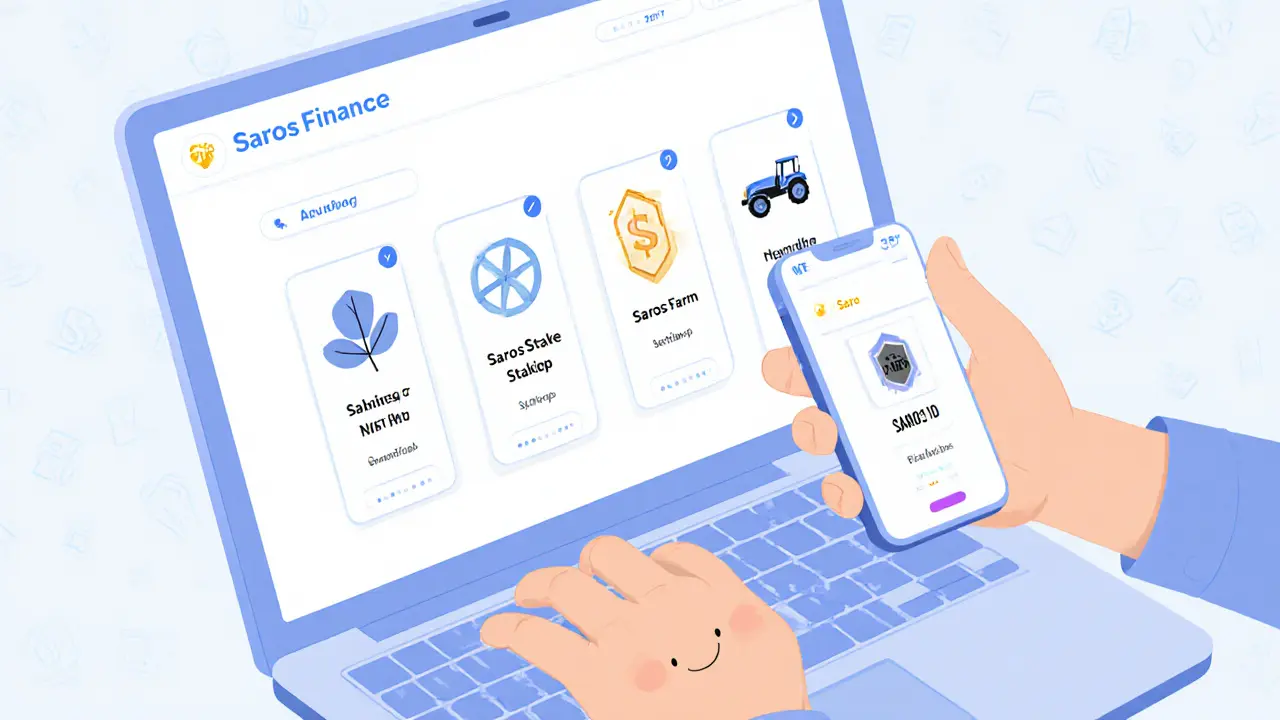SAROS Staking Calculator
Calculate your potential earnings from staking $SAROS. Based on Saros Finance's tokenomics:
- Base fee: 0.20% per swap (0.16% for $SAROS holders)
- 50% of fees distributed to stakers, 50% burned
- Current token price: $0.4075
- Annual staking yield: ~15-25% (est.)
Estimated Results
Potential Rewards:
0.00
($0.00 equivalent)
Token Burn Impact:
0.00
($0.00 equivalent)
* Based on current fee structure (0.16% for $SAROS holders). 50% of fees distributed to stakers, 50% burned.
Estimated annual yield: ~18-22%. Actual yields may vary based on trading volume and price.
Saros Finance is a decentralized finance (DeFi) ecosystem built on the Solana blockchain that combines a DEX, wallet, staking, farming and NFT services into a single super‑app. Launched in 2021 as SarosSwap, the platform has expanded into what the team calls a "New Generation Liquidity Engine" with the recent rollout of Dynamic Liquidity Market Maker (DLMM) v3. If you’re wondering whether Saros lives up to the hype, this review breaks down the user experience, tokenomics, security and market performance as of October 2025.
What Users See When They Open Saros Finance
The first thing you notice is a clean, web‑friendly dashboard that pulls together five main modules: the DEX (SarosSwap), a non‑custodial wallet, the NFT Hub, SarosStake and SarosFarm. The UI feels more like a modern fintech app than a typical crypto interface, which helps newcomers feel at home while still offering depth for seasoned traders.
- SarosSwap - the core automated market maker where you can swap SPL tokens with near‑zero slippage thanks to the DLMM engine.
- SarosStake - a single‑click staking portal for the $SAROS token that compounds rewards automatically.
- SarosFarm - incentivized liquidity pools designed for project creators to bootstrap market depth.
- NFT Hub - a marketplace and minting tool that leverages SolanaPay and AI‑assisted artwork generation.
- Saros ID - a unified identity layer that links your wallet, staking profile and NFT collection under one handle.
Because everything sits behind the same login (generated by Saros ID), you never need to hop between separate sites. The experience is comparable to a traditional finance super‑app like Revolut, but for crypto.
Technical Backbone: Solana + DLMM v3
Under the hood, Saros runs on Solana blockchain, which currently processes around 65,000 transactions per second with sub‑second finality. That speed translates into practically free trades - most swaps cost less than $0.0001 in network fees.
The real differentiator is the Dynamic Liquidity Market Maker (DLMM) v3, launched in April 2025. Unlike classic AMMs that rely on fixed‑ratio pools, DLMM v3 creates dynamic price curves based on real‑time order flow, allowing traders to execute large swaps without the usual price impact. In plain terms, you get deeper liquidity and less slippage without having to manually split orders across multiple venues.
DLMM v3 also powers the DEX Aggregator, which sources hidden liquidity from other Solana DEXes (Serum, Orca, Raydium) and blends it with Saros’s own pools. The result is a best‑price guarantee that usually beats standalone platforms.
Tokenomics: How $SAROS Works
The native SAROS token serves three core purposes: governance, fee discounts and reward distribution. Out of a max supply of 10 billion, 2.625 billion are currently circulating, giving the protocol room for future burns and liquidity injections.
Deflationary Mechanics: Every trade on Saros incurs a small fee (0.2% by default). Half of that fee is redistributed to $SAROS stakers, and the other half is earmarked for periodic token burns. This creates a feedback loop where higher platform usage directly reduces supply, theoretically supporting price appreciation.
In terms of distribution, 30% of the total supply was allocated to the team and advisors (vested over four years), 20% to early investors, and the remaining 50% is held in the community treasury for future incentives.
Performance-wise, $SAROS exploded from an all‑time low of $0.000998 in August 2024 to a peak of $0.4075 in mid‑2025 - a 40,800% gain. Analysts at DigitalCoinPrice project a possible high of $0.82 by year‑end, assuming the current growth trajectory and continued whale accumulation.

Security and Audits
Saros Finance has undergone two major audits: one by CertiK in early 2024 and a follow‑up by Trail of Bits after the DLMM v3 upgrade. Both reports flagged only low‑severity issues that were patched within weeks. The platform also employs a bug‑bounty program that has paid out over $250 k in rewards to white‑hat researchers.
Since the ecosystem is non‑custodial, users retain full control of their private keys. The wallet integrates hardware‑wallet support (Ledger, Trezor) and biometric login on mobile, adding another layer of safety.
Institutional Backing and Partnerships
Credibility is a big hurdle for new DeFi projects, and Saros has secured backing from notable players: Solana Ventures, Hashed and Arche Fund. These investors have collectively poured over $40 million into the ecosystem, primarily into liquidity provision and ecosystem grants.
Strategic collaborations include a SolanaPay integration for real‑world merchant payments and an AI‑driven NFT minting service that lets creators generate artwork on‑the‑fly, lowering entry barriers for artists.
How Saros Stacks Up Against Competitors
Below is a quick side‑by‑side look at SarosSwap versus two other popular Solana DEXes - Serum and Orca. The table focuses on the aspects most users care about: fees, slippage, liquidity depth and user experience.
| Metric | SarosSwap | Serum | Orca |
|---|---|---|---|
| Base fee | 0.20% | 0.25% | 0.30% |
| Average slippage (10k USDC swap) | 0.03% | 0.12% | 0.08% |
| Liquidity (USDC‑SOL pool size) | $450 M | $320 M | $210 M |
| UI rating (user surveys) | 9.2/10 | 7.8/10 | 8.1/10 |
| Governance token | $SAROS | $SRM | $ORCA |
Overall, SarosSwap leads on fees, slippage and liquidity depth, while also offering a more intuitive UI. That makes it a solid pick for both casual traders and liquidity providers.

Pros, Cons and Who Should Use Saros
- Pros
- Ultra‑low fees thanks to Solana and DLMM v3.
- All‑in‑one super‑app reduces the need for multiple wallets.
- Deflationary $SAROS token aligns incentives with usage.
- Strong institutional backing adds credibility.
- Regular audits and bug‑bounty payouts boost security confidence.
- Cons
- Regulatory uncertainty still looms over DeFi, especially for staking rewards.
- Reliance on Solana means exposure to network outages (though rare).
- Advanced features like DLMM v3 may confuse absolute beginners.
- Best for
- DeFi enthusiasts looking for low‑cost, high‑speed swaps on Solana.
- Investors who want to earn passive yield via $SAROS staking without impermanent loss.
- NFT creators who want integrated minting with AI assistance.
Future Outlook
The roadmap shows three major milestones for 2026: (1) cross‑chain bridges to Ethereum and Polygon, (2) launch of a DeFi‑as‑a‑Service layer for developers, and (3) expanded AI tools for personalized portfolio recommendations. If those deliver, Saros could evolve from a Solana‑centric DEX into a multi‑chain DeFi hub.
Market sentiment remains bullish for DeFi, and Saros’s strong HODL metrics - exchange balances down 58% while whale wallets added 0.29% in the last month - suggest confidence among big players. However, investors should stay mindful of overall crypto volatility and potential regulatory crackdowns on staking rewards.
Bottom Line
In a crowded Solana landscape, Saros Finance stands out by bundling a fast, fee‑efficient DEX with a suite of user‑friendly services and a token model that rewards activity. The DLMM v3 engine addresses the usual liquidity pain points, and the platform’s institutional backers give it a legitimacy edge. If you’re comfortable with the inherent risks of DeFi, the platform is worth a serious look - especially for traders who value speed and low costs, and for long‑term holders who want to stake $SAROS without worrying about impermanent loss.
Is Saros Finance a centralized exchange?
No. Saros Finance is a fully decentralized platform built on Solana. Users keep control of their private keys, and all trading, staking and NFT actions occur on‑chain.
How does the DLMM v3 differ from regular AMMs?
DLMM v3 creates dynamic price curves that adapt to real‑time order flow, reducing slippage on large trades. Traditional AMMs use static curves, which can cause price impact when the pool size is small.
What are the fees for swapping on SarosSwap?
The base fee is 0.20% per swap. $SAROS holders receive a 20% discount, bringing the effective fee down to 0.16%.
Can I earn rewards without providing liquidity?
Yes. By staking $SAROS in SarosStake you earn automatically compounded rewards, and there’s no risk of impermanent loss because you’re not supplying a token pair.
Is Saros Finance safe from hacks?
The platform has passed two major audits and runs a bug‑bounty program. While no system is 100% immune, the security track record looks solid for a DeFi project of this size.


Jireh Edemeka
October 20, 2025 AT 09:10Oh great, another “deflationary” token that pretends you’re funding the ecosystem just by swapping. The 0.2% fee split-half to stakers, half to burns-sounds shiny, but remember that even a tiny burn rate barely dents a 10 billion supply. In practice you’re just paying for the privilege of holding $SAROS while the project hopes the hype drives volume.